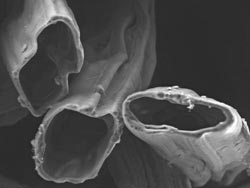Multi-talented textiles

Greatly enlarged image of a cross-section of regenerated cellulose fibres.<br>©Kelheim Fibres<br>
In the ZIM research project KF2136709HGO, researchers from the internationally renowned Hohenstein Institute in Bönnigheim worked with Kelheim Fibres, one of the leading manufacturers of special viscose fibres, to investigate the many and diverse ways of using newly developed multifunctional regenerated cellulose fibres.
The ability of functionalised regenerated cellulose fibres to absorb extremely high quantities of water means that they can be used in very many different ways. The aim of the research project was to improve the moisture management of existing clothing systems for protection against heat and cold by using a newly developed hydrophilic fleece. The researchers also hoped to open up additional areas of application for the new fibres in the fields of medicine, cosmetics and cleaning.
The clothing that is currently available on the market to provide protection against heat and cold does protect the human body well from low temperatures. However, the most common combinations of materials are only to a limited extent able to absorb significant quantities of perspiration and transport it effectively away from the body. This means that, especially when switching between hot and cold rooms, or under great physical strain, the wearer experiences an unpleasant wet sensation.
In these situations, using a buffer layer made of “super-hydrophilic” fleece, which is particularly good at storing liquid sweat, can be a great help and make the wearer feel much more comfortable.
The Hohenstein researchers investigated many other ways in which the new fibres could be used because of their ability to absorb great quantities of water, in addition to clothing for heat and cold protection.
In the fields of medicine and cosmetics, for example, not only water but medical or cosmetic substances could be deliberately incorporated in the fibres, to be released later for a specific purpose.
Since the fibres take on a gel-like consistency when they are damp, they could also be used for medical purposes in dressings, wet wound healing and the treatment of severe burns.
Another possible area of application for the absorbent fleece is to make cloths or other products for soaking up liquids. This ongoing research project is extremely interesting and promising for many different industries.
As a result of this investigation, the Hohenstein researchers expect that, on the basis of their fundamental research, it will be possible greatly to improve the comfort and thermophysiological quality of protective clothing without having a detrimental effect on its thermal insulation properties.
In addition, the Hohenstein scientists and their industrial partner Kelheim Fibres are also hoping, in view of the many possible applications for the novel fibres, to be able to open up new markets and develop other innovative products.
Media Contact
More Information:
http://www.hohenstein.de/en/inline/pressrelease_10818.xhtmlAll latest news from the category: Materials Sciences
Materials management deals with the research, development, manufacturing and processing of raw and industrial materials. Key aspects here are biological and medical issues, which play an increasingly important role in this field.
innovations-report offers in-depth articles related to the development and application of materials and the structure and properties of new materials.
Newest articles

Properties of new materials for microchips
… can now be measured well. Reseachers of Delft University of Technology demonstrated measuring performance properties of ultrathin silicon membranes. Making ever smaller and more powerful chips requires new ultrathin…

Floating solar’s potential
… to support sustainable development by addressing climate, water, and energy goals holistically. A new study published this week in Nature Energy raises the potential for floating solar photovoltaics (FPV)…

Skyrmions move at record speeds
… a step towards the computing of the future. An international research team led by scientists from the CNRS1 has discovered that the magnetic nanobubbles2 known as skyrmions can be…





















